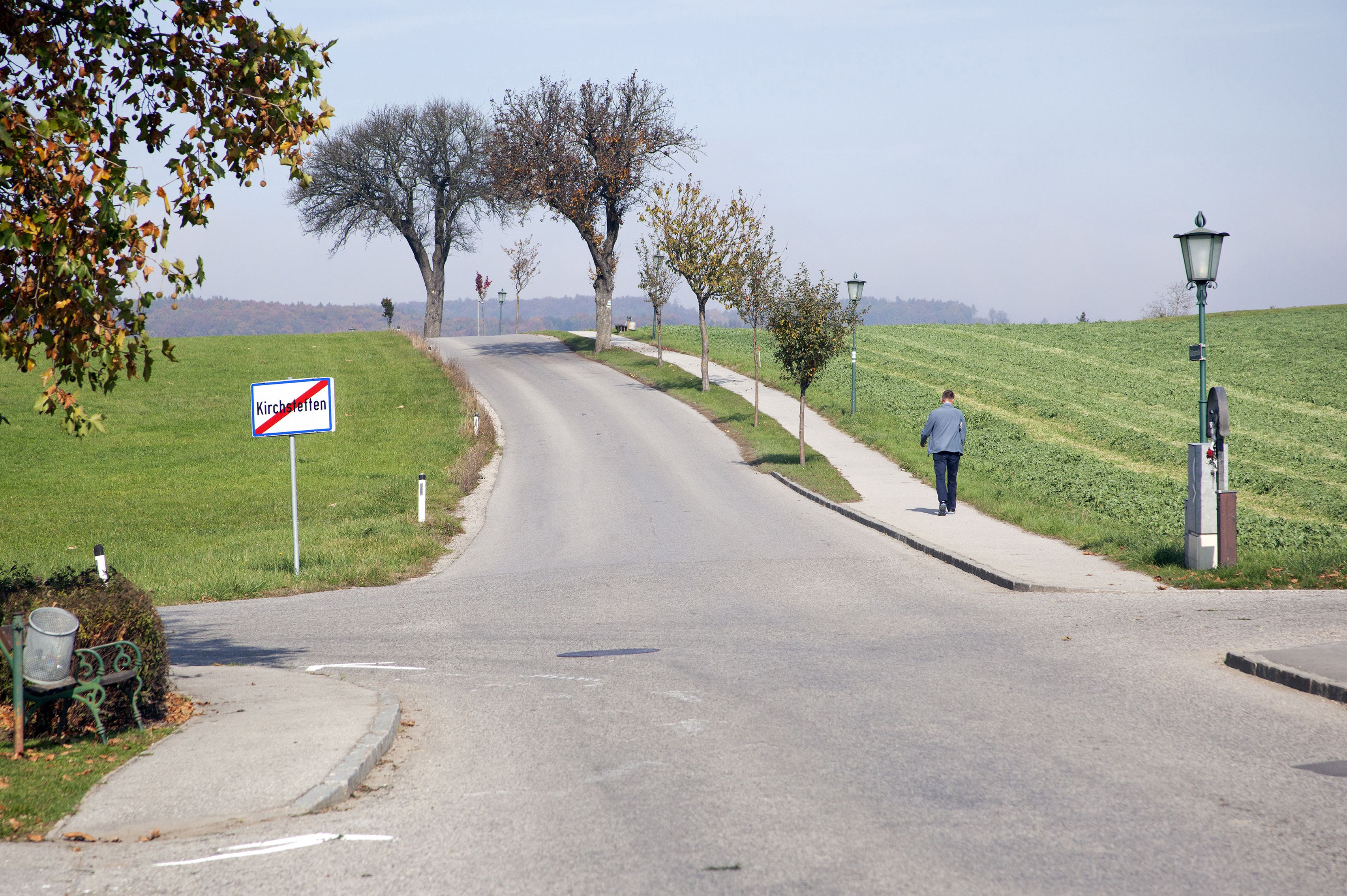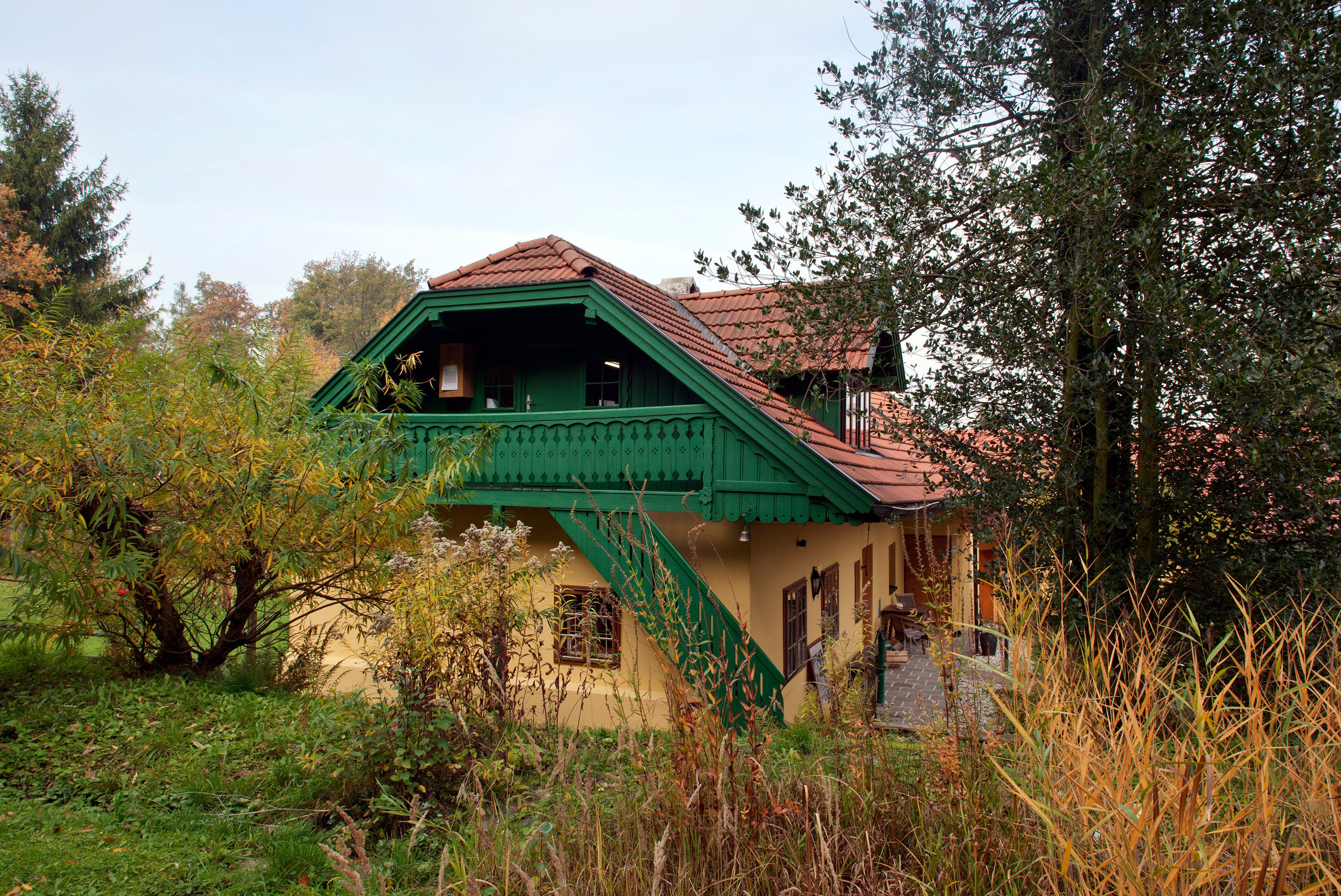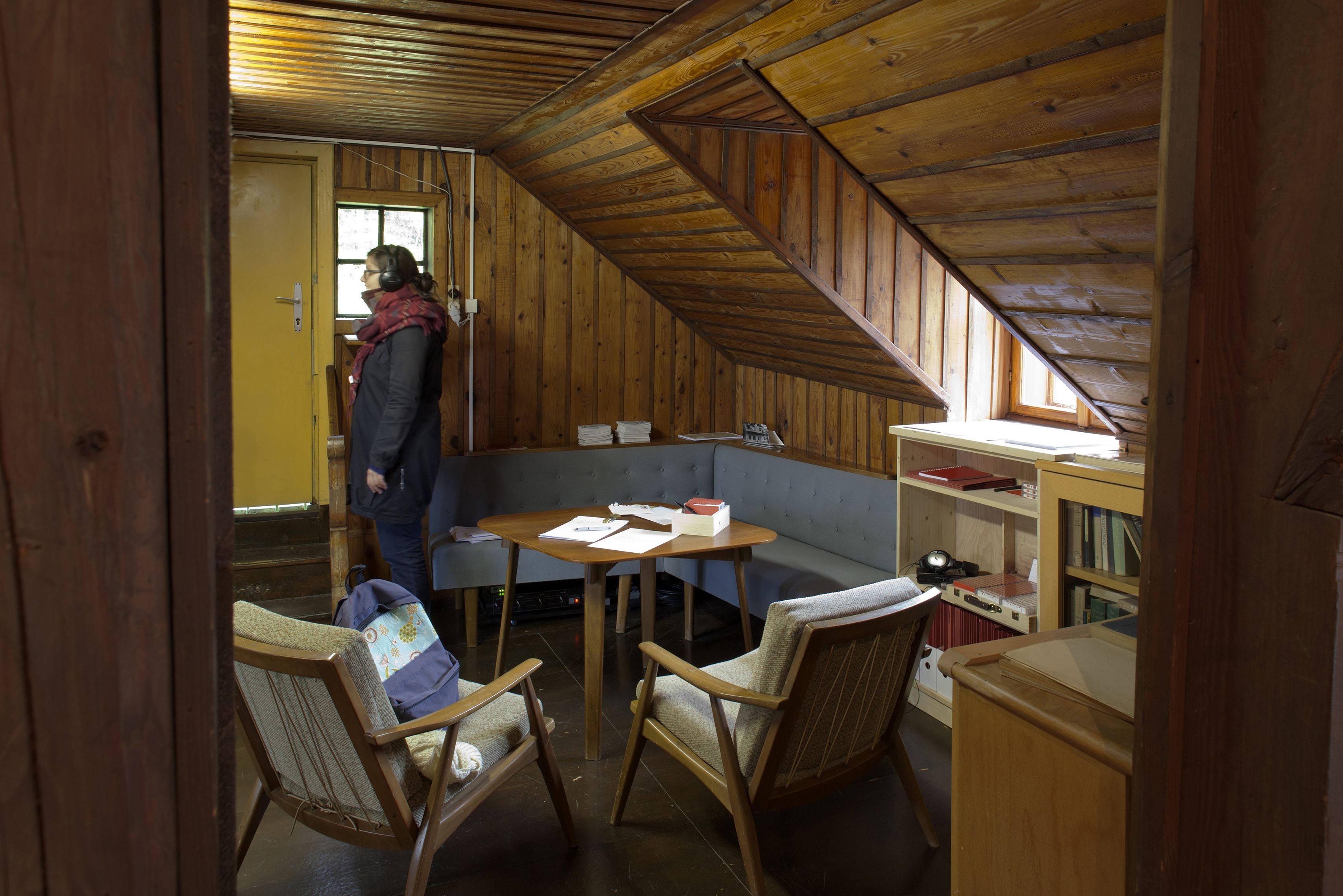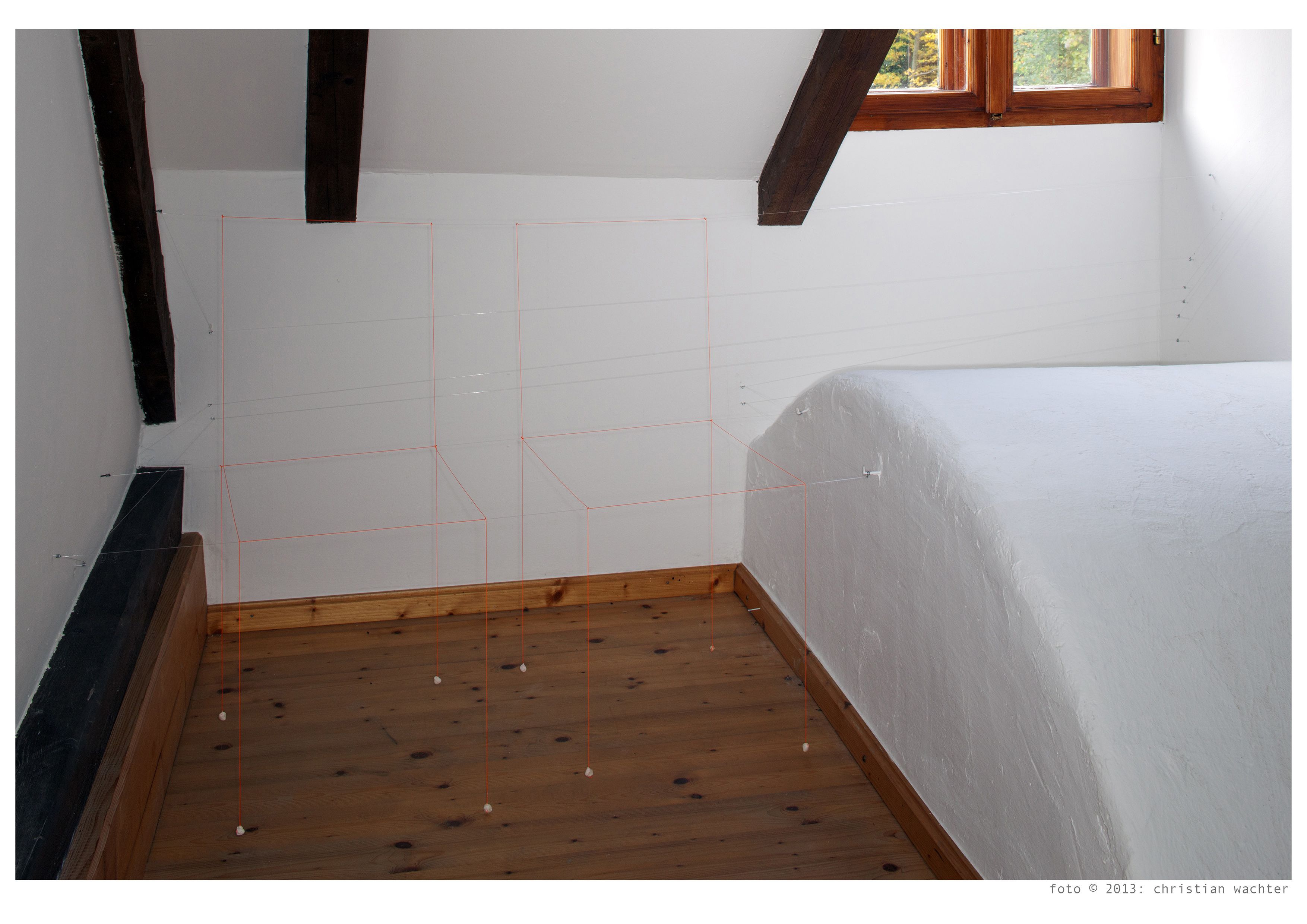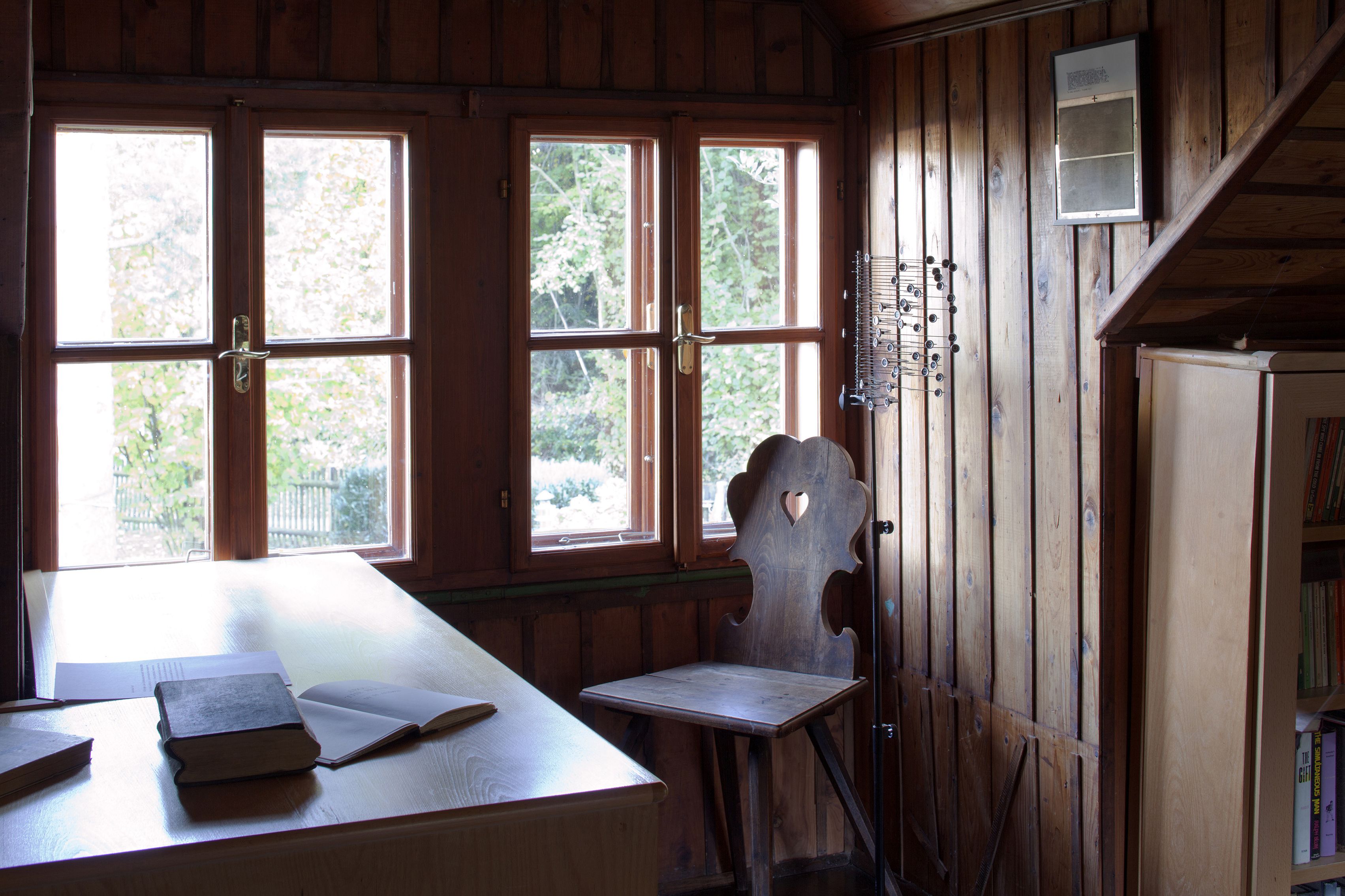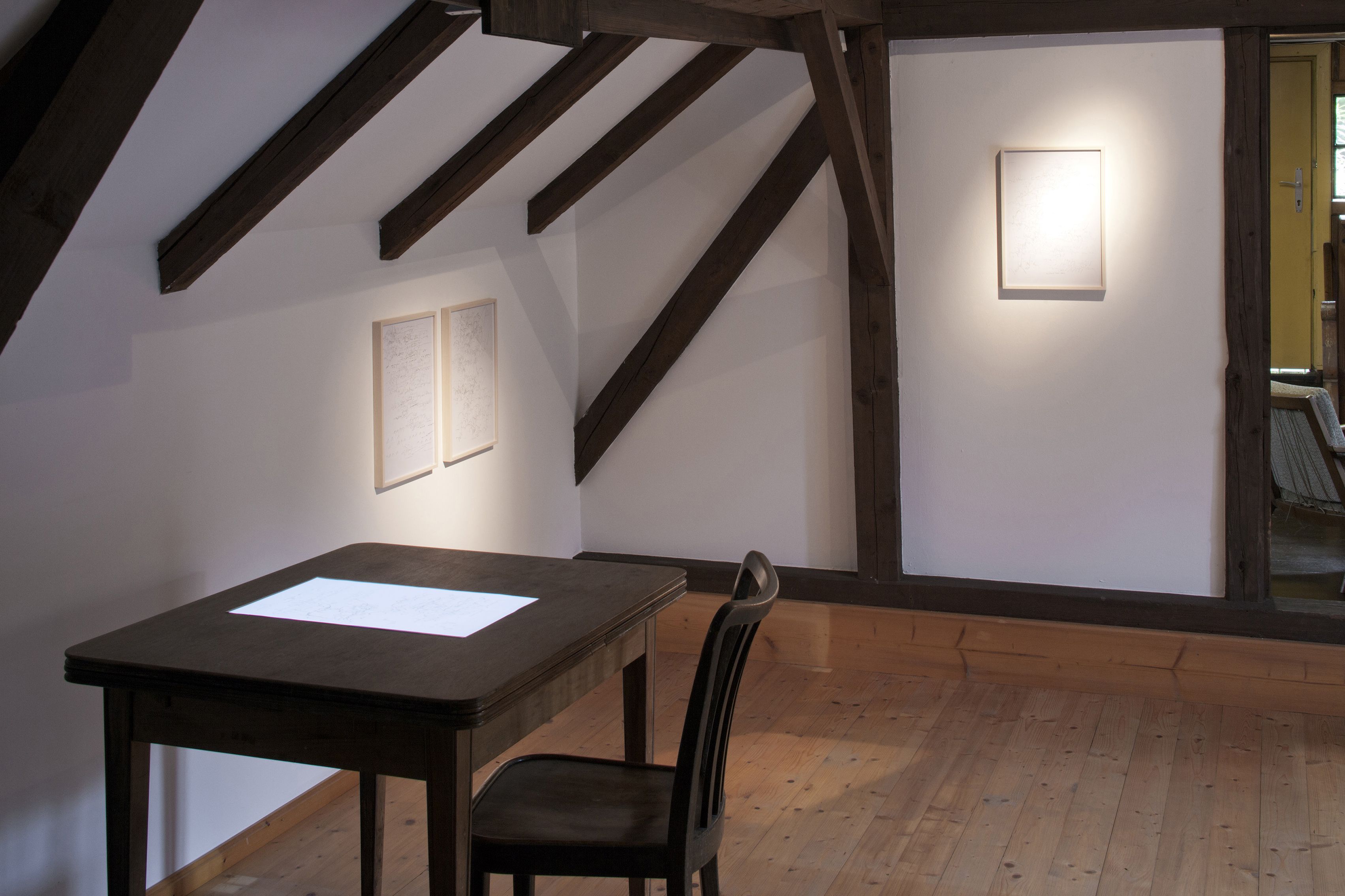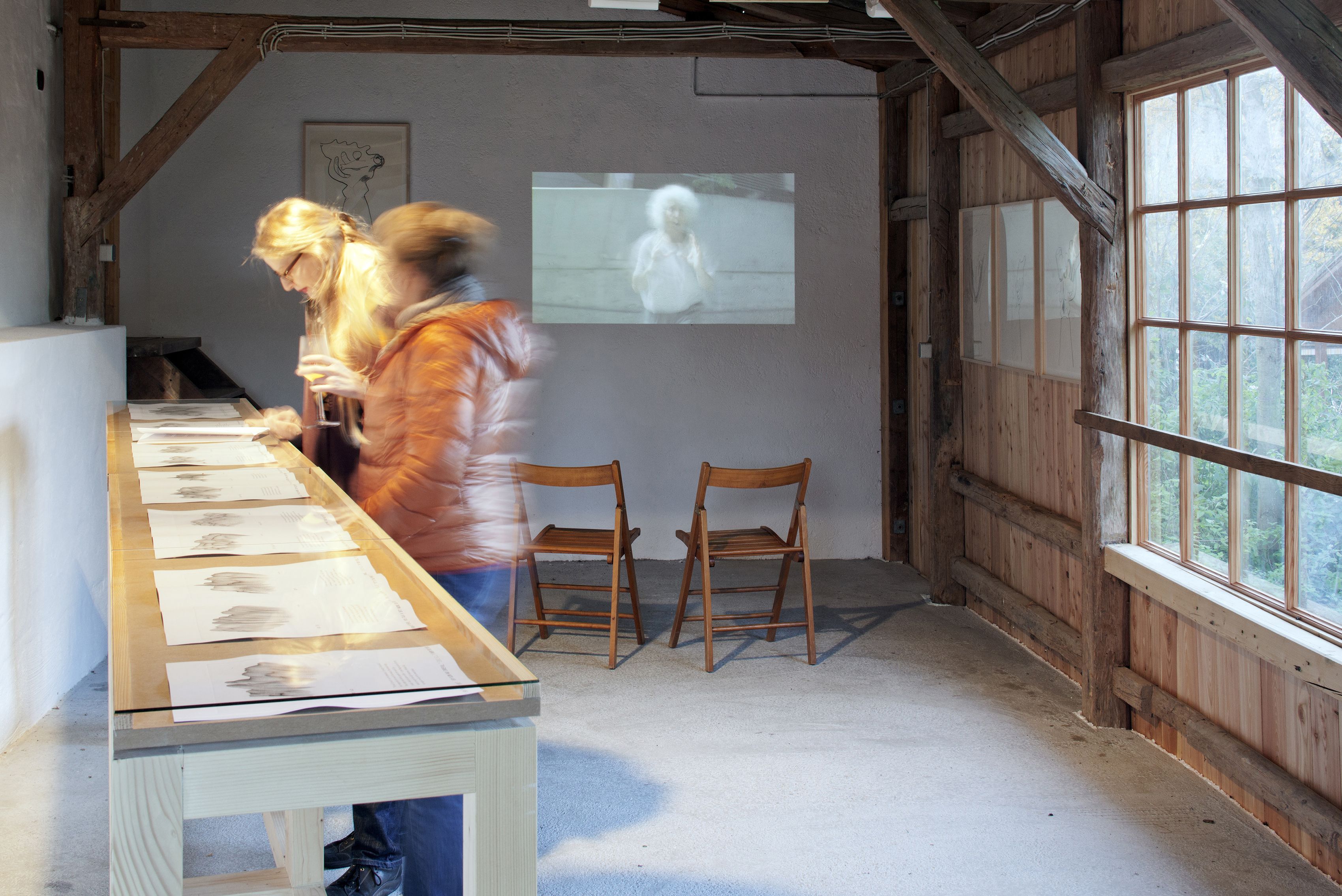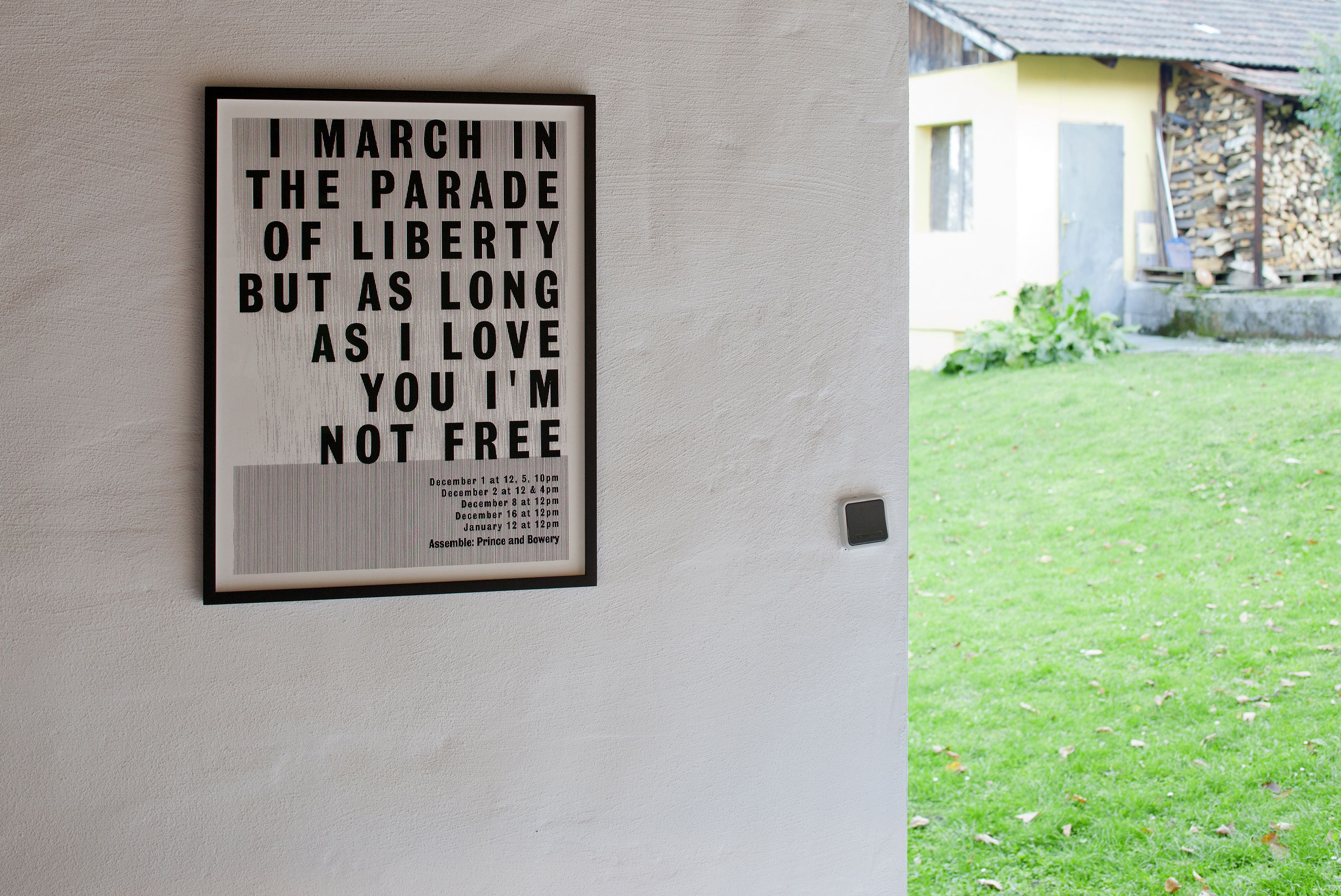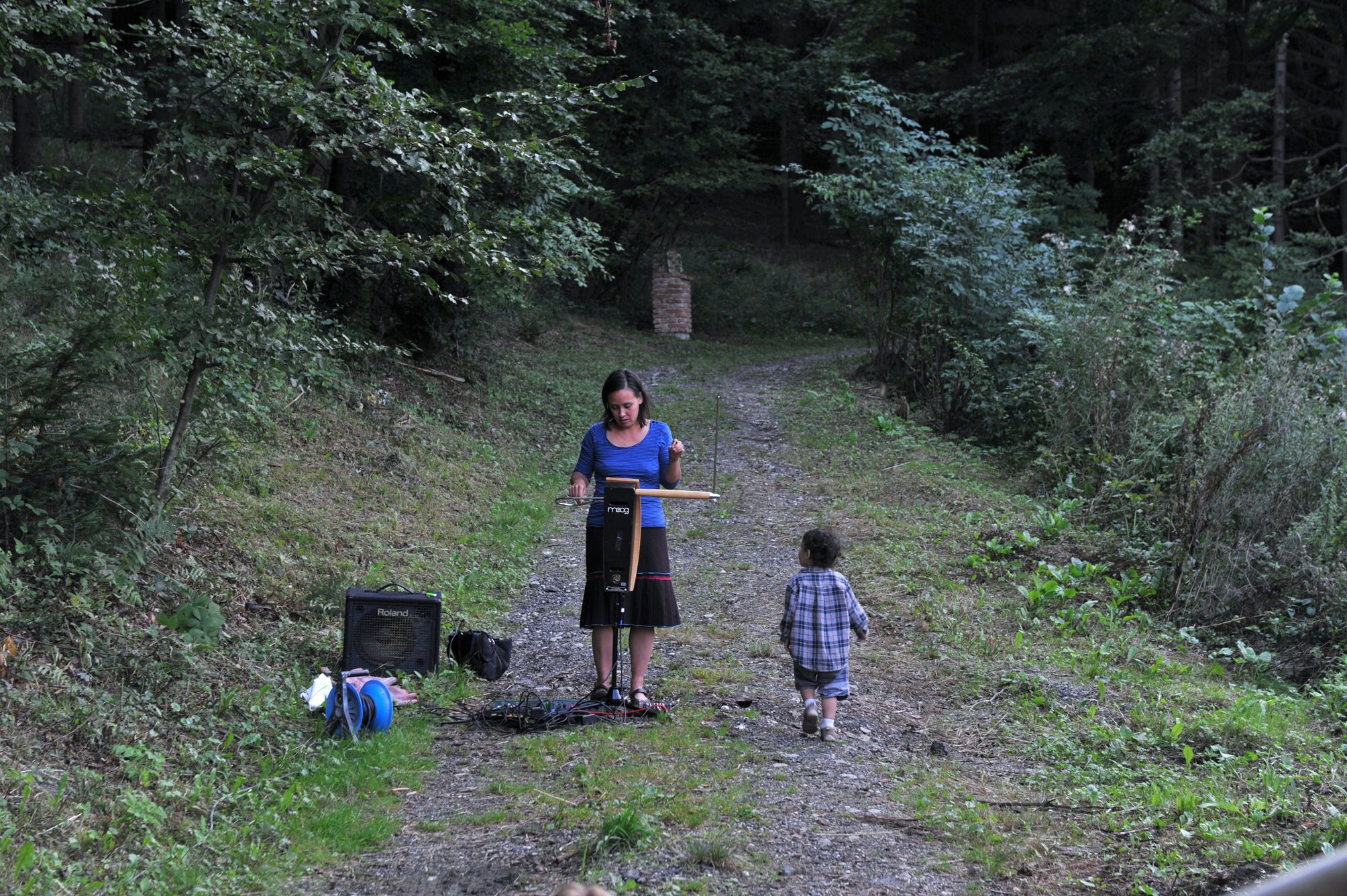About The House. Silence Turned Into Objects. [exhibition]
BackArtists
- With
Information
"About The House. Silence Turned Into Objects" is an art project by the artist Ricarda Denzer that takes the form of an exhibition inspired by the life and work of the Anglo- American, Pullitzer Prize-winning poet Wystan Hugh Auden (1907-1973), who lived in this house for much of the year from 1958. Works by 12 artists that engage with language in different ways are on display in the village aswell as at the Auden House. It is about hearing and the voice as well as about the speech act, and its transformation into visual, spatial and socio-political dimensions.
Contributors
- Kuration
Contributions
Brandon LaBelle
"Hideout for a Creole Imaginary“, 2013
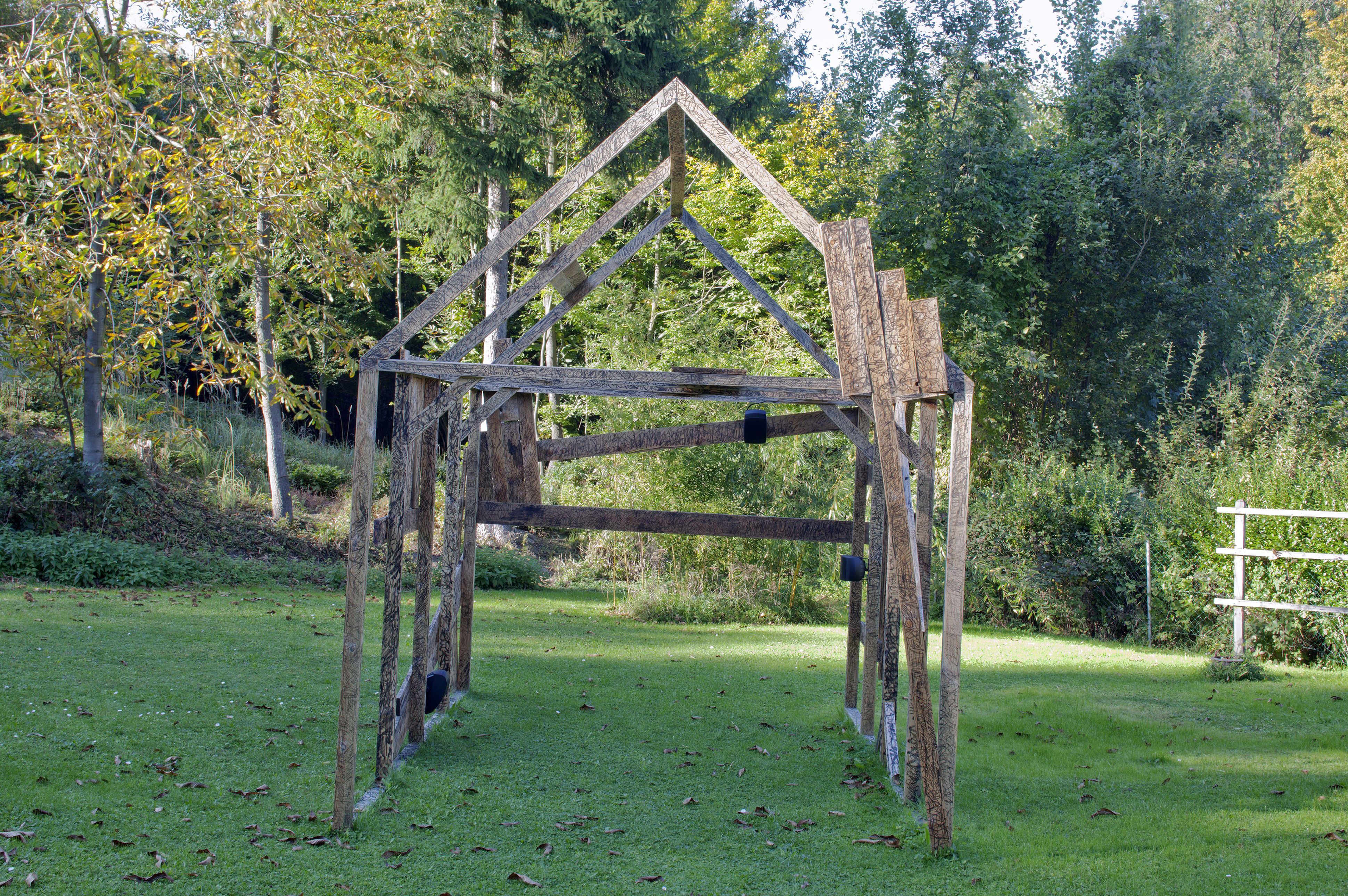
"The one who is full of imagination; the one who is on the move; the one who crosses lines, bridges gaps, is lost in the crowd; the one who migrates; the one who searches for connection; the one who mis-speaks and mis-hears; the one who dreams of palm trees, apple pie, rum and wine; the one with a restless tongue; the one that is always already elsewhere; the one who transverses and interjects; the one from the other side of the tracks; the one who creates a new home, here"
(Brandon LaBelle)
The installation by the artist, writer and theorist Brandon LaBelle stands on a lawn in the garden of the Auden House. He describes it as "an architectural diagram outlining a space for the Creole imagination: the hybridity of tongues, the poetics of relations, the migration of ideas". The structure of wooden slats clearly resembles a three-dimensional sketch of a house where everything has been only half-envisaged and is to be completed with the power of imagination. The slats are covered in abstract black scribbles. The artist's voice and somebody else's are to be heard as an overlapping, hardly comprehensible whispering: "…In speaking I thought about the voice that travels, the language that migrates, the creole, and this brought me to questions of 'the island' and 'the empire', which is a thread throughout the speaking." (Brandon LaBelle)
Brandon LaBelle uses sound and text installations, performance and interventions in public space to explore issues relating to social life and activity as well as social communication. In the collection of poems Thanksgiving for a Habitat W.H. Auden devotes one poem to each of the rooms in his Kirchstetten house. In these poems he reflects on the relevant function of the room in his everyday private life, on human nature and the human condition. The house stands for the I-construction. In this context Brandon LaBelle's Hideout can be seen as a we-construction, representing the hybrid nature of contemporary societies where Creole incursions are regarded as introducing creative disorder. As Brandon LaBelle writes: "It might be where we can live in the future, or where we might store the voices of a crowd soon to come. An echos-monde, here to there".
(Cornelia Offergeld)

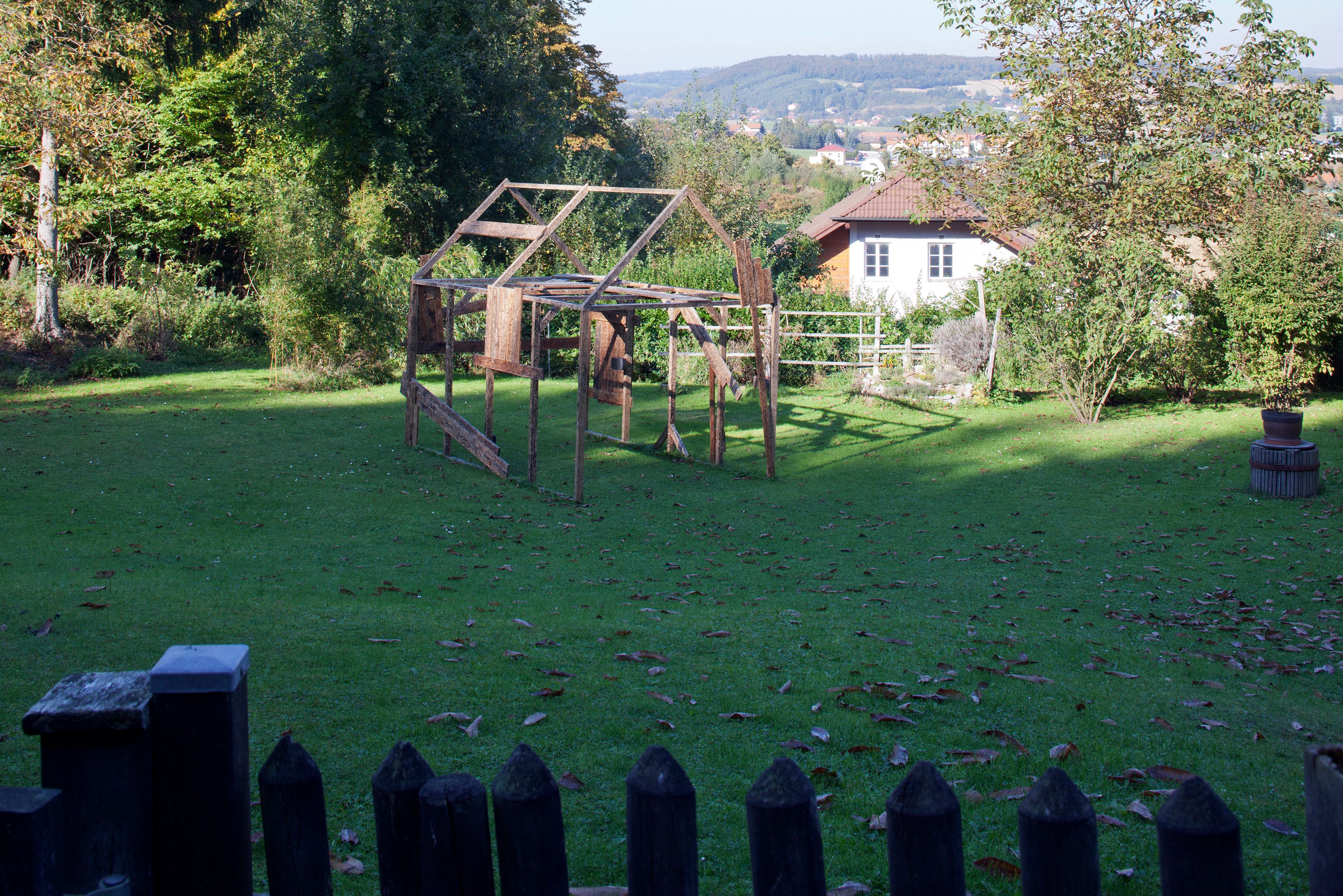

Annette Stahmer
"A ist blau" (2009), "Synästhetische Bilder" (2010/2013)

The work of the Berlin-based artist and typographer Annette Stahmer revolves around the topic of language, with a focus on the relation between speech and writing, the act of writing, as well as memory, palimpsest, and synaesthesia. She is particularly interested in the “materiality of language” and explores this mainly through video and sound projects, photograms and different forms of performative diaries.
In the two works on exhibit, this is developed through working with the artist’s mother, who as a synaesthete is able to experience colors corresponding to each of the vowels. The video "A is blue" (2009) captures her at her desk as she speaks to herself, describing the vowel sounds and their corresponding colors. This is complemented by an image of her painting the colors, creating an audio-visual meditation on this intermingling of the senses.
Continuing with this theme, the second work "Synesthetic Pictures" (2010/13) is a sound work whose ‘picture’ is created within the listener’s mind. This occurs by following the voice of the artist’s mother as she journeys through different colorful pictures or scenes, which she seems to describe, but which are in fact translations of the vowel sounds into her inner corresponding colours, for instance, „The night… the night… the night is translucent blue. The moon is black. The fog… the fog is white. The sea is white. The garden… the garden… is light blue. The house… the house is blue-black … “
The focus in both works is on language that, following synaesthesia as an expression of an inner logic, serves not only as a description of this phenomena, but becomes in itself a sort of substance, assuming colour and consistency and which evokes within the listener poetic, almost surreal images.
(Cornelia Offergeld)


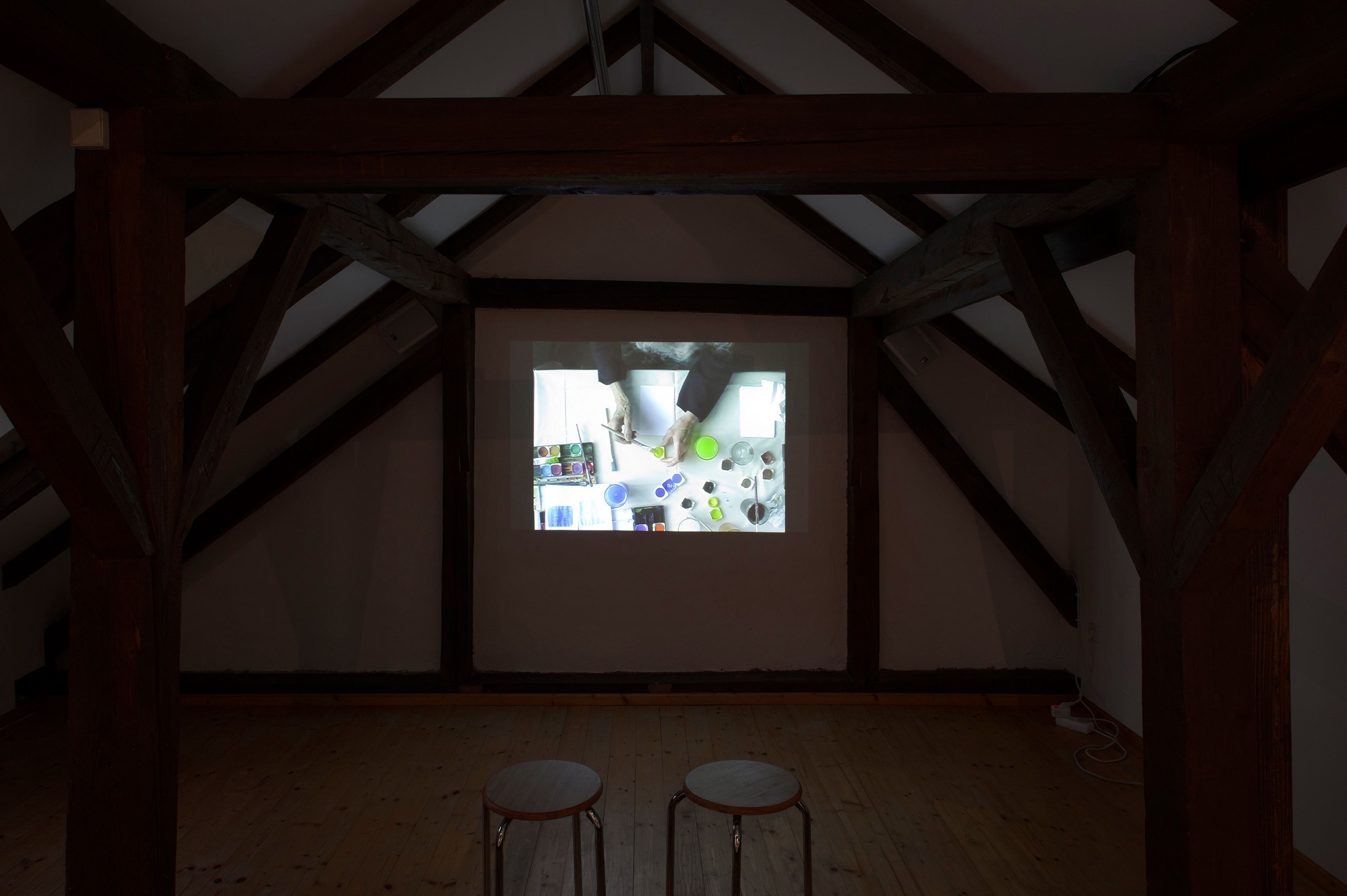
Ultra-red
"Politics (in Private)", 2013
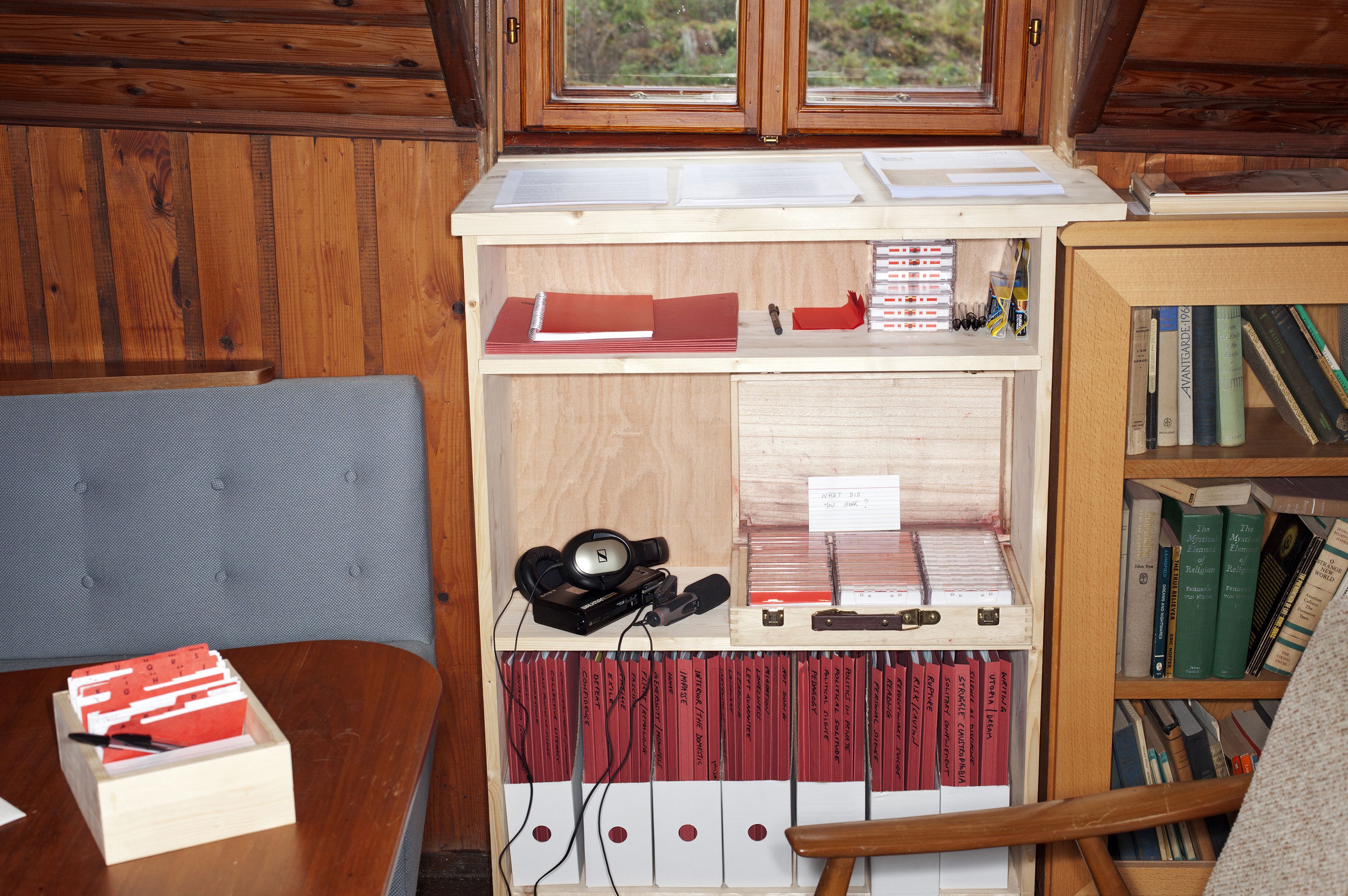
"Politics (in Private)" is an extension of the Auden archives by the participation of visitors to the Auden House. In this specific context, the artist collective Ultra-red has reflected on the state of loneliness and the associated potential, and invites people to send their own written contributions on the topic to the Auden House by post: "Politics (In Private) consists of a thematically organized collection of texts and annotations made on file cards about those texts. It also contains audio files on cassette tape. There is also a study area with pens, blank file cards, blank cassettes, headphones, a microphone and a letter opener. There is seating for up to four people to work, discuss and study. Mail containing new texts and annotations for this collection is delivered by post to the house and is placed for opening on top of the shelves."
The artist collective Ultra-red, founded in 1994, is engaged in a dialogue between art and political activism. Its members are: "artists, researchers and organisers from different social movements including the struggles of migration, anti-racism, participatory community development, and the politics of HIV/AIDS." …Exploring acoustic space as enunciative of social relations, Ultra-red take up the acoustic mapping of contested spaces and histories utilising sound-based research (termed Militant Sound Investigations) that directly engage the organizing and analyses of political struggles". (Ultra-red, online mission statement)
(Cornelia Offergeld)

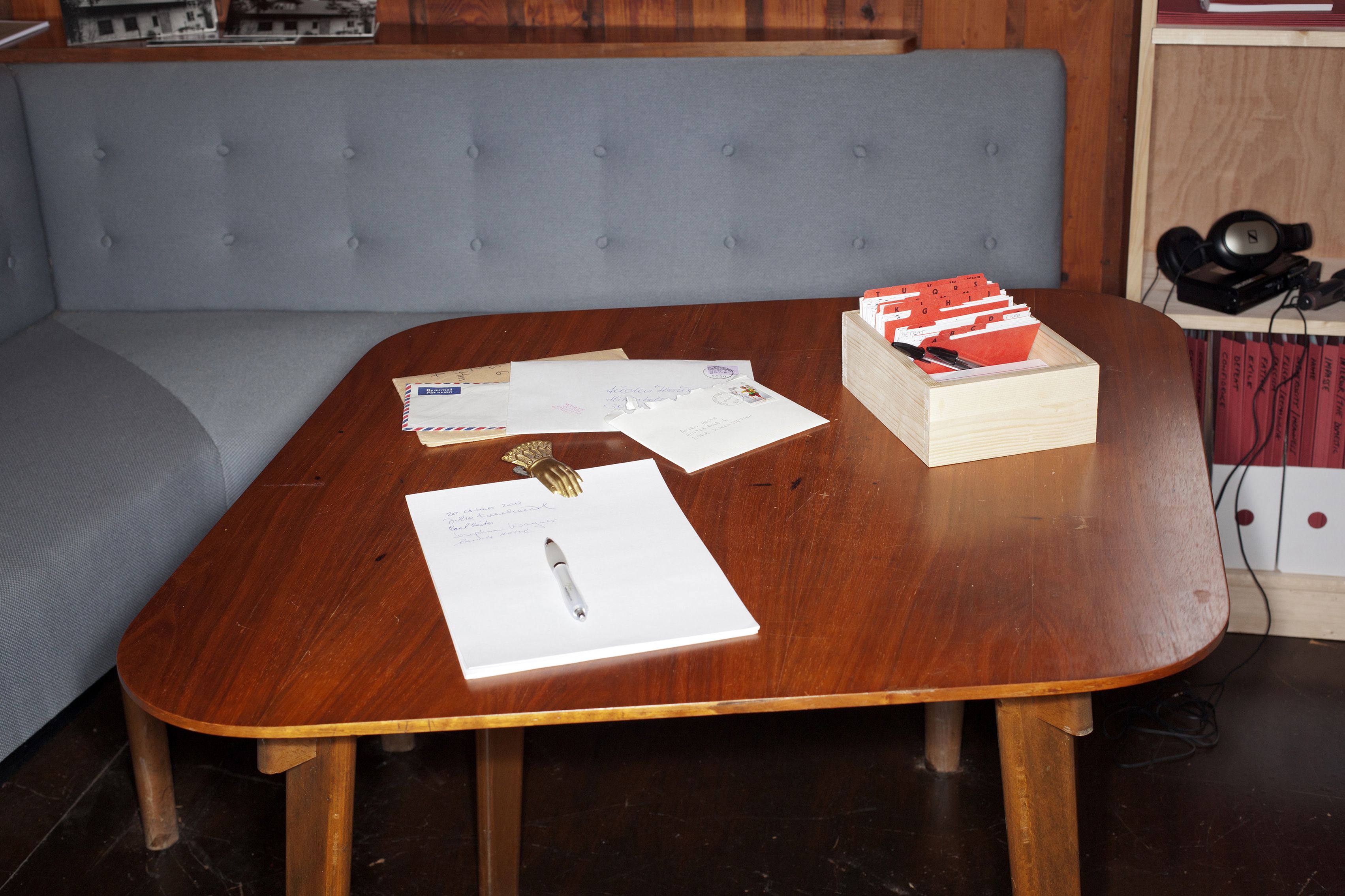
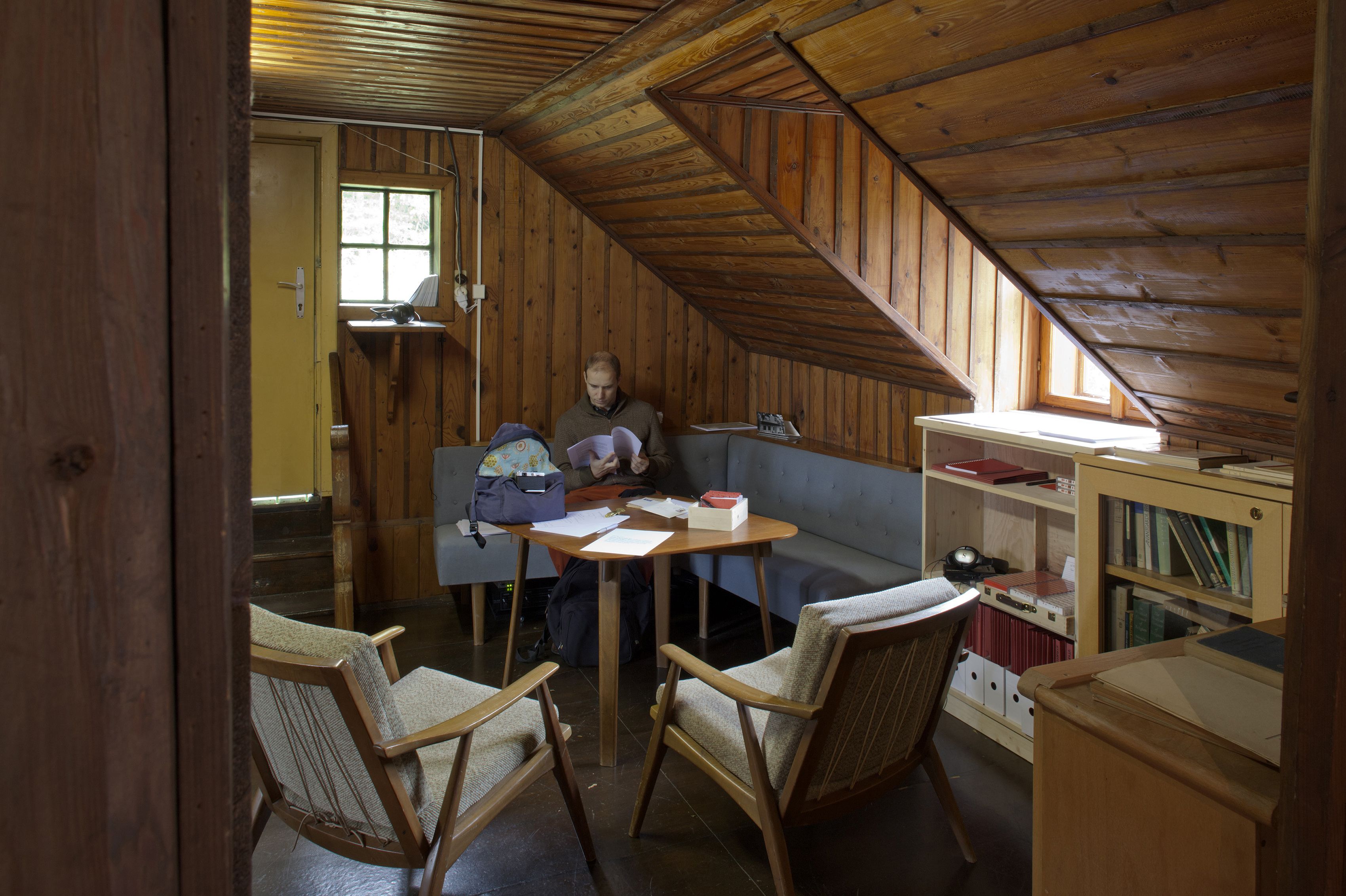
Marcel Broodthaers
"Interview with a Cat", 1970
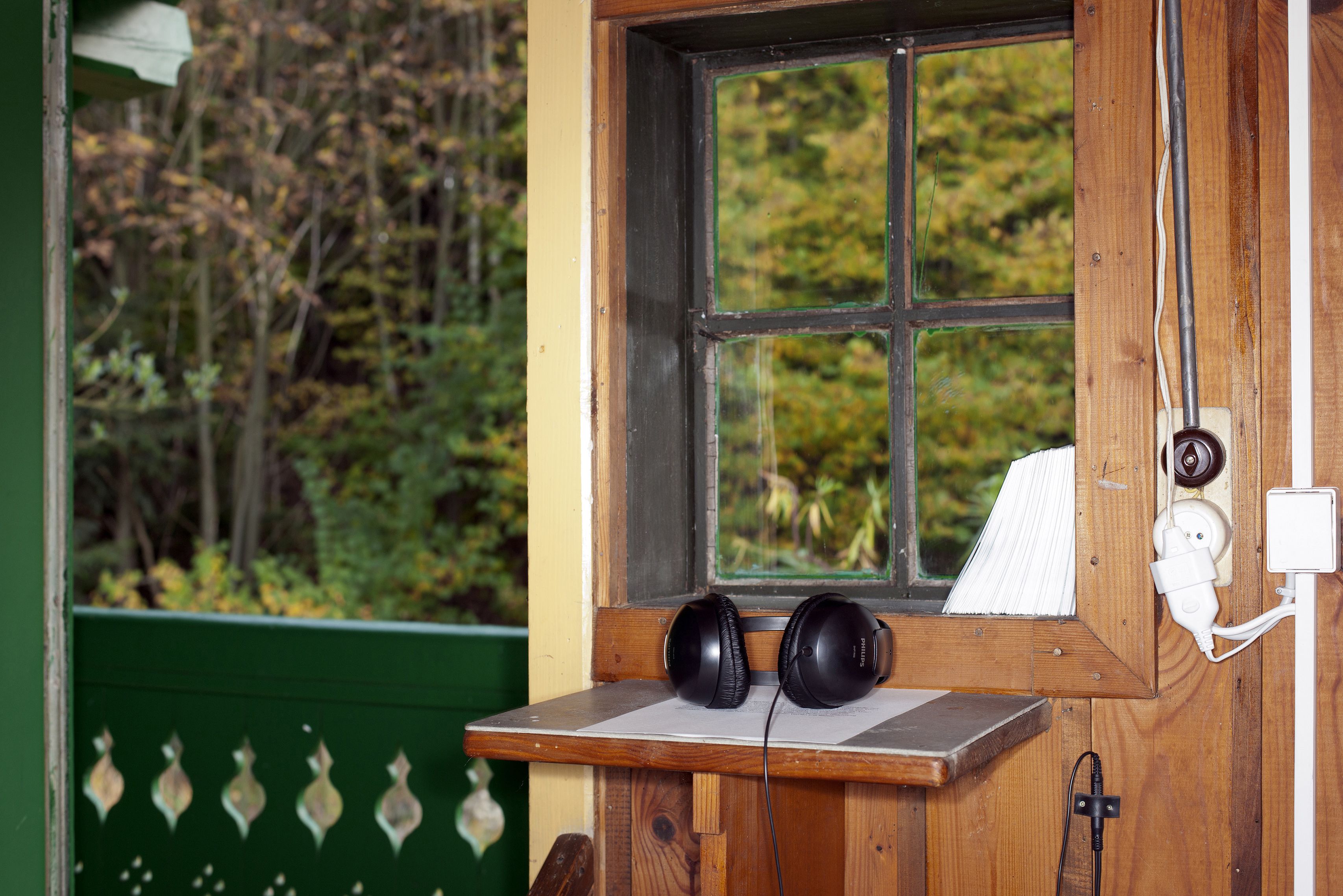
In "Interview with a Cat" Marcel Broodthaers exacerbates his subversive play with language, and unequivocally lets us know that it is not up to the artist to provide answers. He is, instead, more interested in rigorously posing questions. Broodthaers asks a cat questions about painting, museums or the art market, or he would like to know whether a particular painting is innovative or merely academic. Finally, the interviewer alters the sentence by Renée Magritte in the 1929 painting La trahison des images [The Treachery of Images] from "Ceci n’est pas une pipe" to "Ceci est une pipe", repeating himself in different tones of voice to then contradict himself: "Ceci n’est pas une pipe". The cat, in the role of the artist, replies, as is only natural, in cat talk. In a further play on the sentence, in 1972 plaques were completed bearing the phrase "Ceci n'est pas un object d'art / Dies ist kein Kunstwerk".
Marcel Broodthaers recorded the Interview with a Cat in 1970, during his Dusseldorf period, in his self-assembled Musée d'Art Moderne, Département des Aigles. There followed a series of fictive interviews (like Interview Imaginäre de René Magritte or Interview Imaginäre de Marcel Lecomte, both 1967), in which Broodthaers plays the role of the interviewer.
Marcel Broodthaers made the museum, its social significance, and the art market the subject of his critical reflections while engaging with the conditions of artistic production and the reception of art. At the same time he took the question raised by René Magritte about the discrepancies between words and images a stage further as well as about the to and fro between self-recognition and recognition of the object, about the modern subject's entirely adhering to a Romantic tradition.
(Cornelia Offergeld)
Jonathan Quinn
"Two Similar Chairs“, 2013
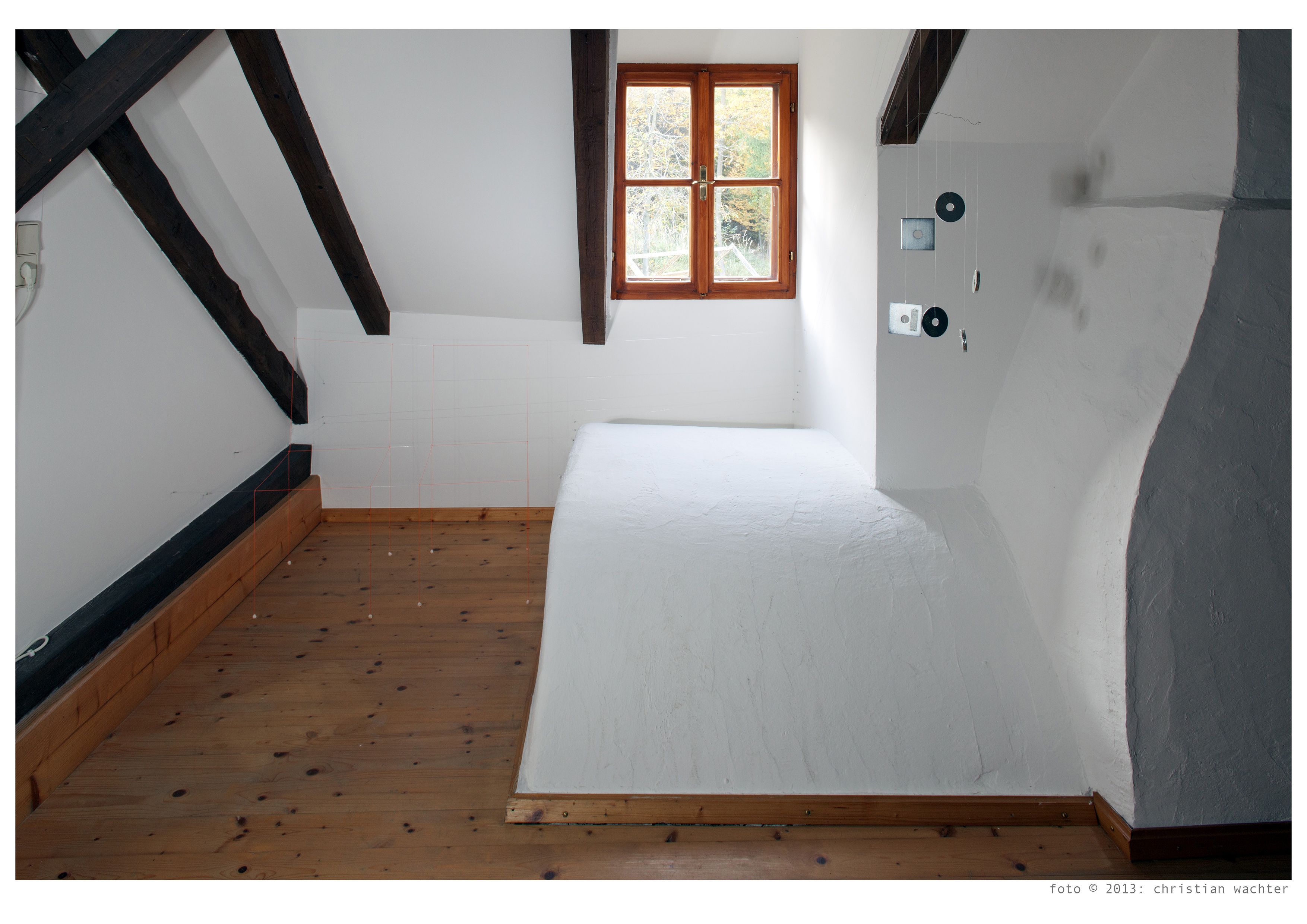
With the work "Two Similar Chairs" Jonathan Quinn uses a poetic gesture to remind visitors of the two former occupants of the house: W.H Auden and his partner, with whom he also worked, Chester Kallmann. Jonathan Quinn suspends threads in the space to form a sculpture incorporating the outline of two simple chairs. On entering the room the eye carefully feels out the threads. The memory of things past rushes to help. This process, which lies between seeing the threads and recognising the pieces of furniture is where Quinn's interest lies.
The engagement with modern architecture and design, industrial standardisation and mass production, as well as the process of visual perception are fundamental to Jonathan Quinn's work, in which the suspension of threads has been a key formal feature since the mid-1990s. The site-bound sculptures consist of red and uncoloured acrylic threads held in place only by knots and different weights — usually industrially produced. The outlines are reminiscent of fleeting annotations in the space, sketches of furniture whose mass has dissolved, or of language, which can only outline things. So it appears only consistent that after the exhibition these threads are scrunched together by the artist to make small Tangles. In a post-structuralist linguistic context these sculptures can be regarded as an analysis of signifier, sense and meaning. Although it should not be overlooked that Jonathan Quinn's thread installations are themselves both deconstructions and constructions. In their fragility and transience they establish their own reality, one which is removed from everyday language and, beyond any insistence on meaning, they transform objects into silence.
(Cornelia Offergeld)
Fatih Aydoǧdu
"Klavier ([un]translatable)“, 1984/2013

"For Klavier ([un]translatable)", the work installed in what was once W.H. Auden's study, Fatih Aydoğdu transformed concepts ascribed to literature and music — language, scale, musicality, rhythm and sound — into a form of visual poetry. He combined the historical hardware of a writer and that of a musician in one instrument. The assemblage, of the keyboard from an old typewriter and a music stand, is offset by a collage from an old printing plate and a poem by Aydoğdu written in 1984. The shadow cast onto the wall from the rounded typewriter keys and the music stand changes with the lighting and the position of the sun, and can be regarded as a continually shifting abstract image. The artist employed the grammar and sound of the Turkish language for the poem. The text, however, is not immediately comprehensible. It consists of invented words and portmanteau words that can be connected to many different ideas and have many different connotations. So a different narrative can emerge depending on the reader's subjective associations. The language means different things and evokes different images depending on the associations it arouses.
In his art Fatih Aydoğdu engages, among other things, with sonic and semiotic systems. Language and music are shown as complex systems that the artist explores in parallel on multiple levels, linguistically as well as sociologically. In a broad range of formal approaches — from making objects, sound installations and video installations, to drawing — as an artist, designer, sound artist and curator, Aydoğdu engages with socio-political aspects of mediatised spaces and media aesthetics, identity politics and linguistic concepts.
(Cornelia Offergeld)
Olga Karlíková
"Audible Landscapes“, 2003/2012
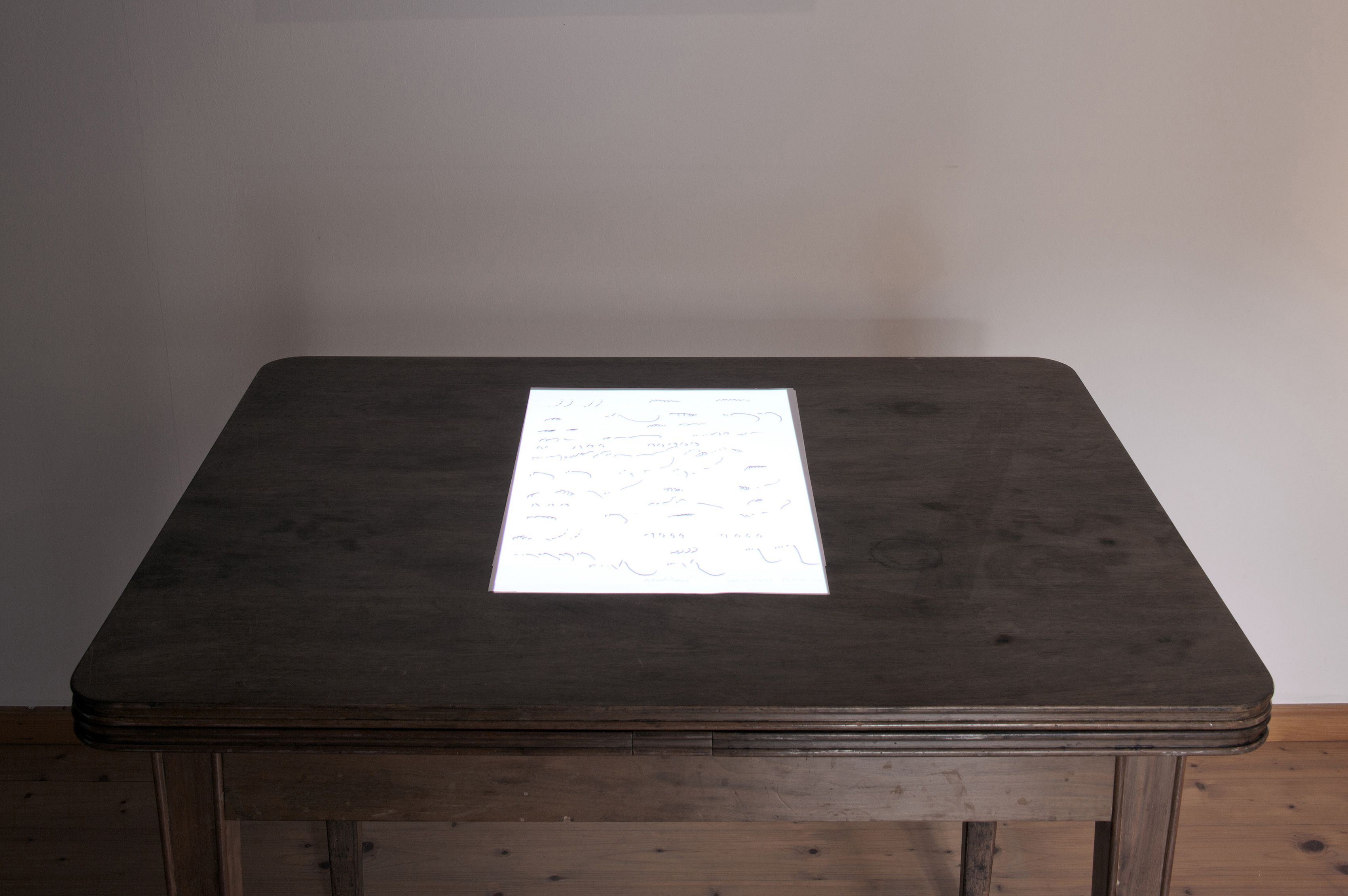
Initially known for her tapestries and abstract works with textiles, since the 1960s Olga Karlíková has dedicated a key focus of her work to drawing in conjunction with music and everyday acoustic phenomena. Alongside her textile works the artist, who was born in Prague in 1923, has developed a system of notation that she uses like sheet music. Until her death in 2004, while observing and listening to birds and frogs she completed thousands of drawings that can be regarded as transcriptions of her acoustic surroundings. Three of these drawings are on display in the Auden House alongside the video installation "Audible Landscapes", which has been specially adapted for the venue. The video, produced by a team of Czech curators between 2003 and 2012, is projected onto a tabletop. It shows over a hundred such drawings by the artist being laid slowly, one by one, on top of one another.
Following the signing of Charta 77, a petition published in January 1977 against the human rights abuses of the Communist regime in Czechoslovakia, Olga Karlíková was banned from working, and her oeuvre was not extensively studied until the fall of the iron curtain. Karlíková's approach to acoustic awareness and her attempts to translate this into graphical signs does not so much pursue an ideological concept but are far more indebted to a poetic approach and an individual language. Accordingly, the artist attempts to develop a method for translating the morphology of nature as well as the language and movements of its fauna that was simultaneously an expression of her subjective impression and an exploration of the possibilities to develop a system of notation for transcribing sounds, rhythm and movements.
(Cornelia Offergeld)
Simone Forti
"Song of The Vowels", 1912
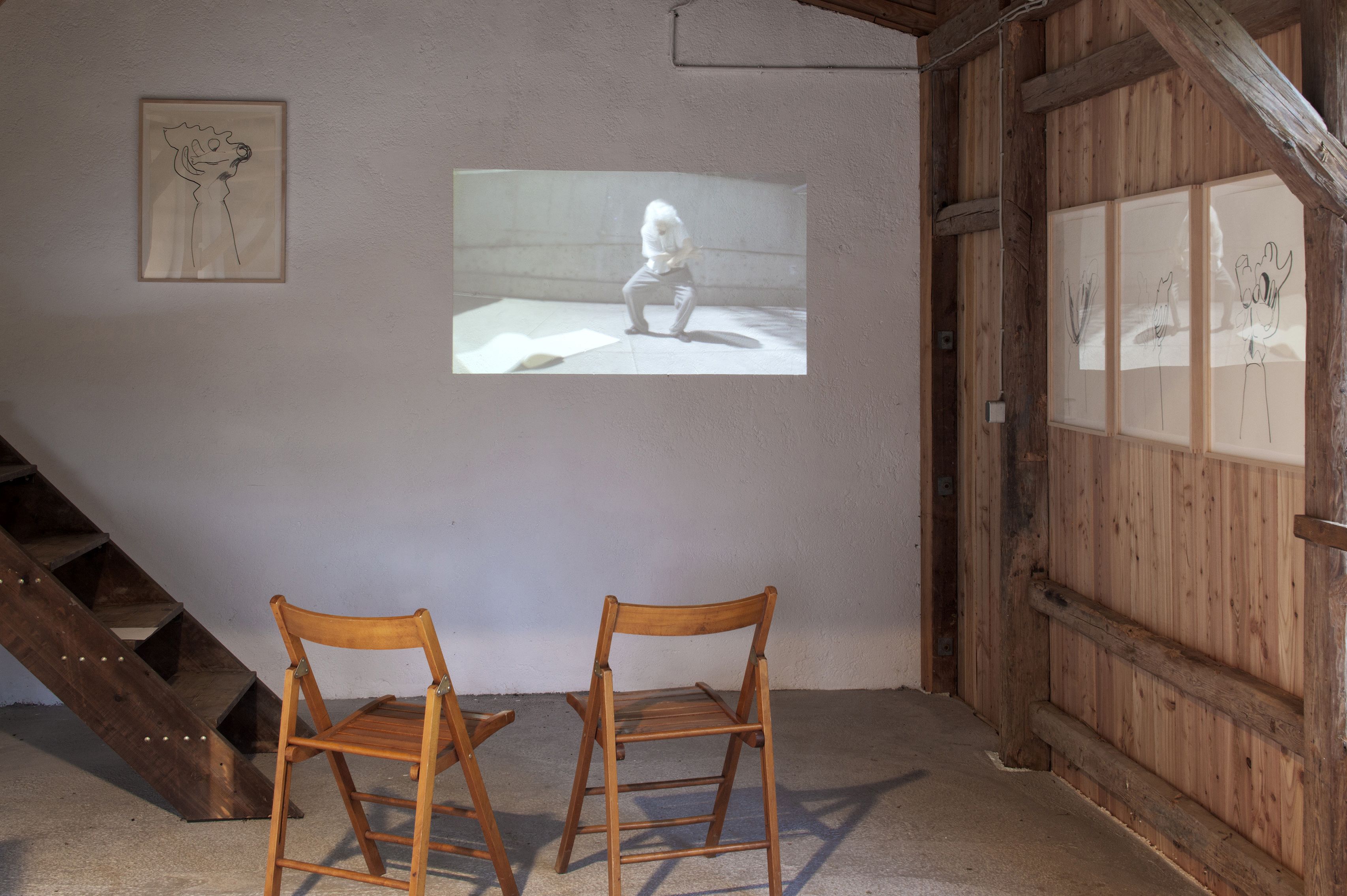
Simon Forti is a choreographer, dancer and musician, visual artist and writer. In her choreographic work the doyenne of postmodern dance in America unites themes such as chance, games and rules, improvisation, speaking and singing. As an artist she is considered one of the key proponents of American Minimal Art. She describes herself as a "movement artist". On display in the Auden House is, alongside her drawings of improvised interpretations of the cubist sculpture of a harp by Jacques Lipschitz (Song of The Vowels, 1931-32), a video projection where Forti — positioned in front of the garage door to her house in Los Angeles — translates these drawings like a score into dance and sound. Intoning short and long vowel sounds, with tones like "Eee eee eee" or "Oh-uuuuu" and using her entire body, she herself becomes an instrument, interpreting the Lipschitz sculpture.
Simone Forti was born in Florence, Italy, and emigrated to the USA in 1939, when she was very young. She became famous for an experimental dance style and choreography largely based on observations of everyday movements, in particular on children and animals as well as on improvisation. One of Forti's great achievements lay in blurring the boundaries between dance and sculpture while introducing a new understanding of space to the visual arts. When, in 1961, she premiered the work group entitled Five Dance Constructions and Some Other Things objects, wooden crates and ramps with ropes which the participants interacted with were spread throughout the loft. The audience could walk around the dancers, so themselves becoming a part of the work. Of the early 1960s Simone Forti said: "We were artists working in the medium of movement".
(Cornelia Offergeld)


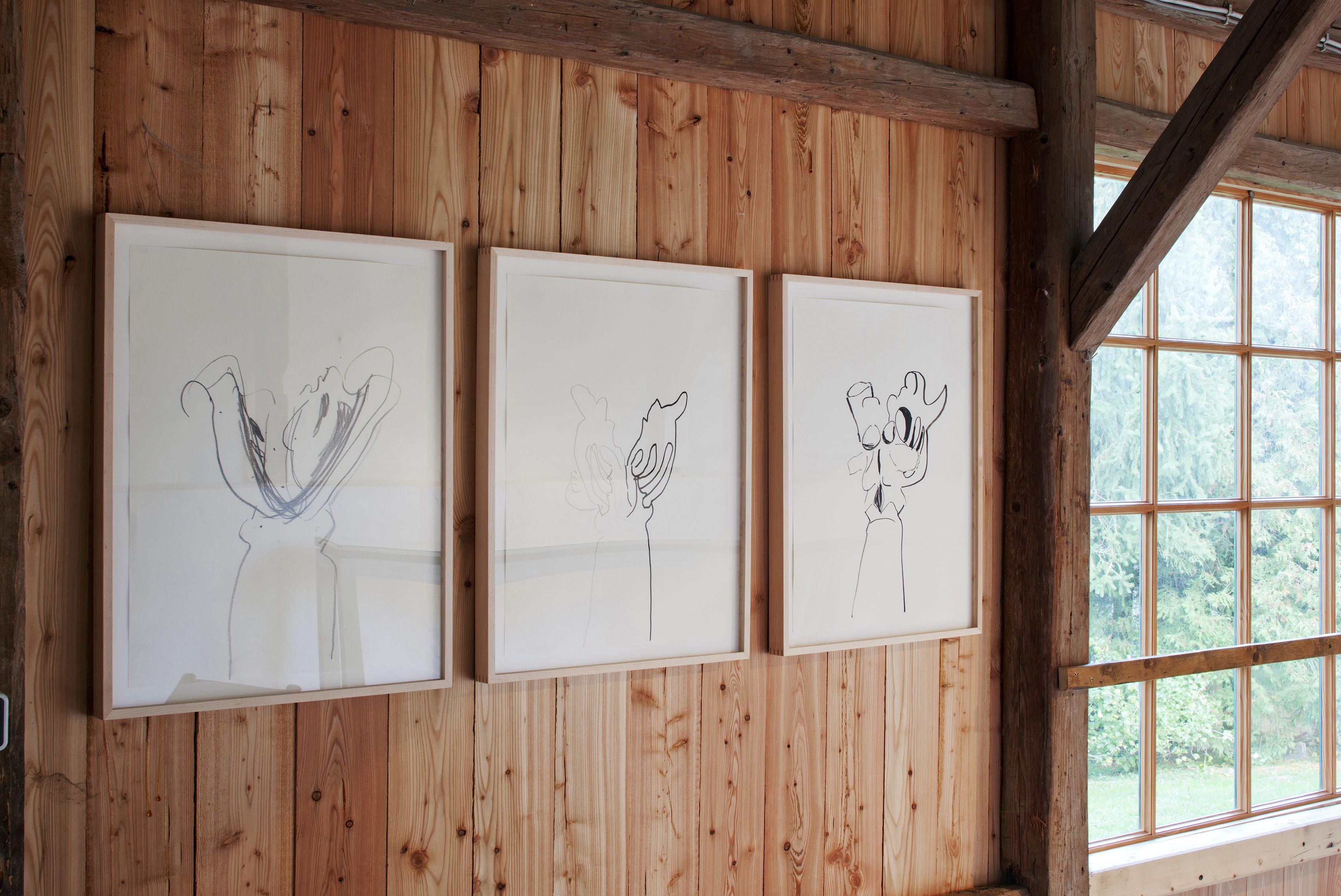
Imogen Stidworthy
"Topography of a Voice“, 2008-2009
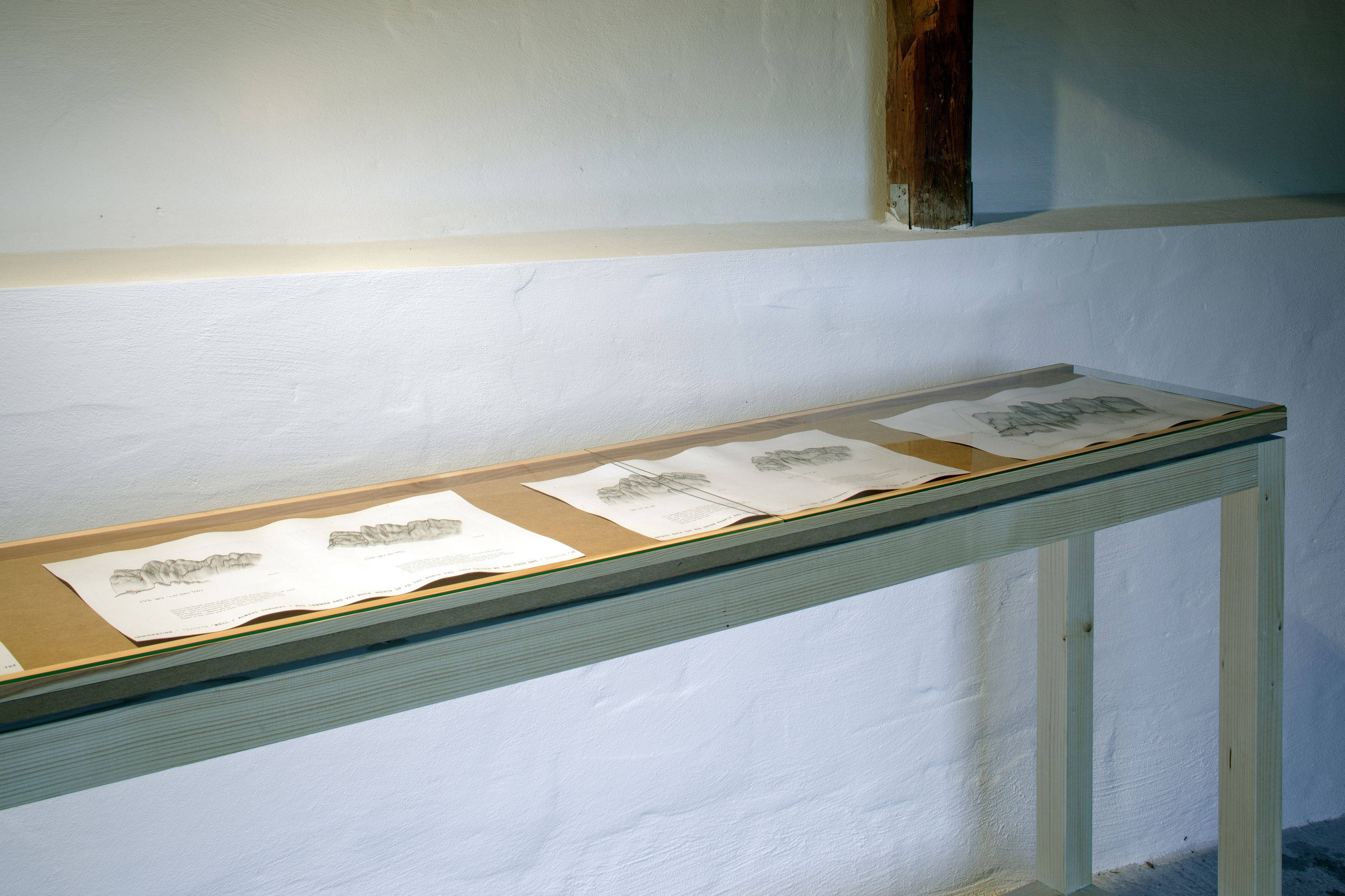
The series "Topography of a Voice" is an attempt to describe a regional accent through different forms of transcription and translation. Imogen Stidworthy asked women in Liverpool to repeat the uniquely Scouse phrase "Get here". These words were then transformed by a voice analysis programme into printed voice-landscapes. The artist made recordings in different neighbourhoods with women from traditional Liverpool families, recent Somali immigrants and actresses from elsewhere who have been trained to speak the accent convincingly. These recordings were transcribed into International Phonetic Alphabet (IPA) and waterfall plots (a graphic display showing decibels, wavelength and duration of a sound).
Parallel to this Stidworthy asked the speakers to reflect on their relationship with the accent and the attributes they associate with it. In the place of a central narrative, she transcribes the words of a voice trainer and dialect specialist who describes the production of the Scouse accent in more physiological terms — a technical analysis which nonetheless betrays some of the stereotypes commonly associated with the accent. The speech samples used for Topography of a Voice originate from a collection made for the installation Get Here, which the artist conceived as a 10.2 surround-sound installation in 2006.
Imogen Stidworthy's films, videos and audio installations explore the characteristics and significance of language, its physical realisation by and relationship to the human body as much as the social and spatial dimensions connected to it. She observes phenomena like voice, the acquisition of language, speech defects or translation processes, and explores the cultural significance of identity and interaction in public space.
(Cornelia Offergeld)
"I march in the Parade of Liberty But As Long, As I Love You I’m Not Free", 2007- 2008
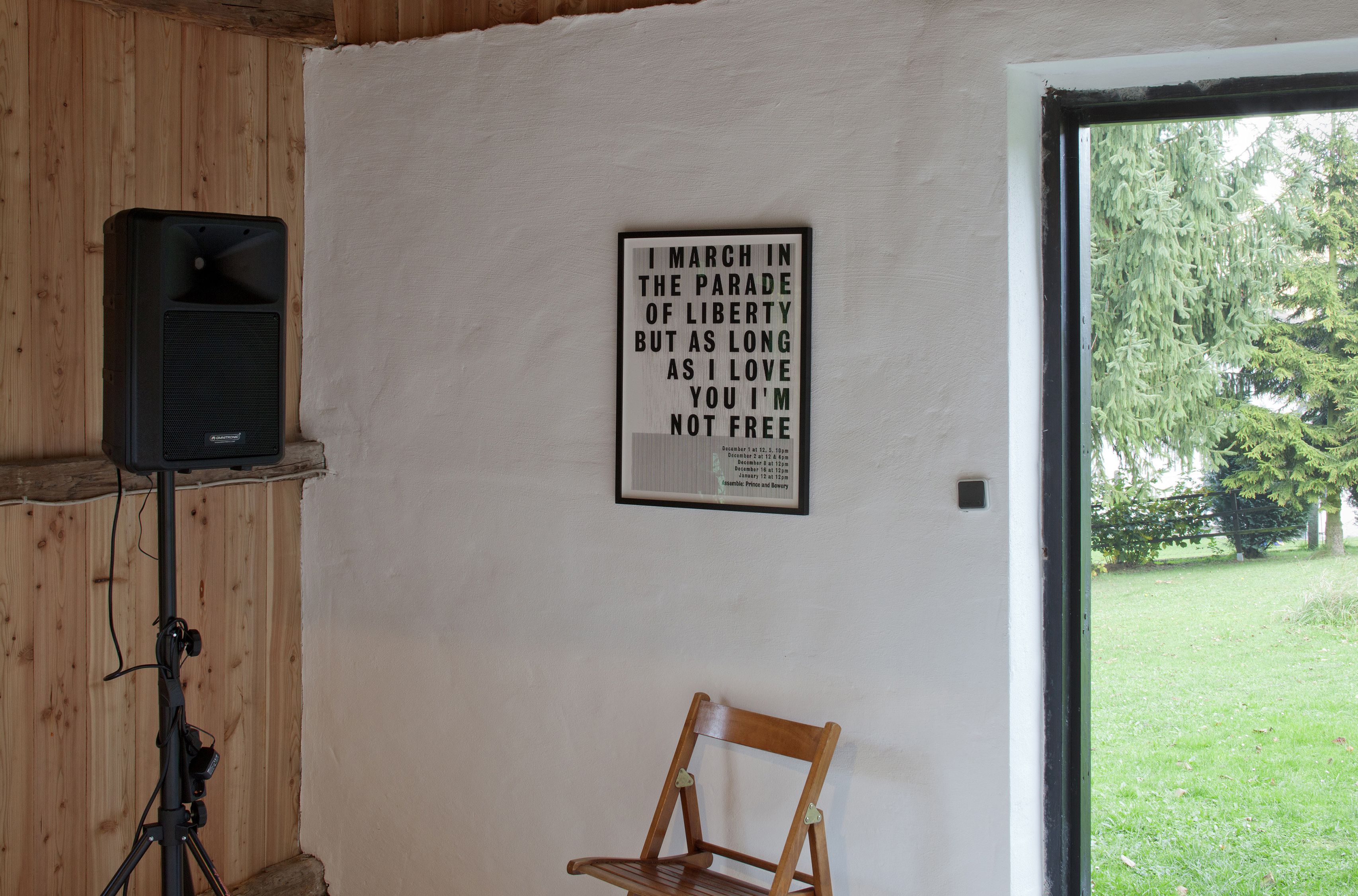
“I March In The Parade of Liberty But As Long As I Love You I'm Not Free” was an eight-part performance where, starting from the New Museum of Contemporary Art in New York, Sharon Hayes walks across eight different public squares — among these: Union Square, Tompkins Square, Confucius Square in Chinatown, and Christopher Street Park — reading a fictive love letter over a megaphone. Sources for the letter were taken from Oscar Wilde's letter written from jail to Lord Alfred Douglas, New York newspaper reports from the early period of the American gay liberation movement, as well as slogans from demonstrations in support of queer rights from 1969 to 1993.
In the Auden House annexe we hear the artist reading the letter aloud. Her explanation: "In this work, I stood on the street with a bullhorn in New York City and spoke a love letter to an anonymous ‘you’. I look like I’m doing ‘public speech’ but I’m speaking to a lover who I’ve been separated from for some reason that the texts don’t quite explain. While I’m talking about love and desire, I am also bringing up the war and the way in which the war interrupts and doesn’t interrupt our daily lives, our activities, our desires, our love. For me, this work attempts to speak about certain intersections between love and politics that aren’t so often talked about." At the same time, she reflects on the difference between speaking and listening as well as on the dialectic between the public and the private realms. In videos, installations and performances in public space, Sharon Hayes subjects the overlaps between history, politics and language to ongoing investigation while engaging with the development of new representation strategies.
(Cornelia Offergeld)
Pamelia Kurstin
"A Solo Performance“, 2013
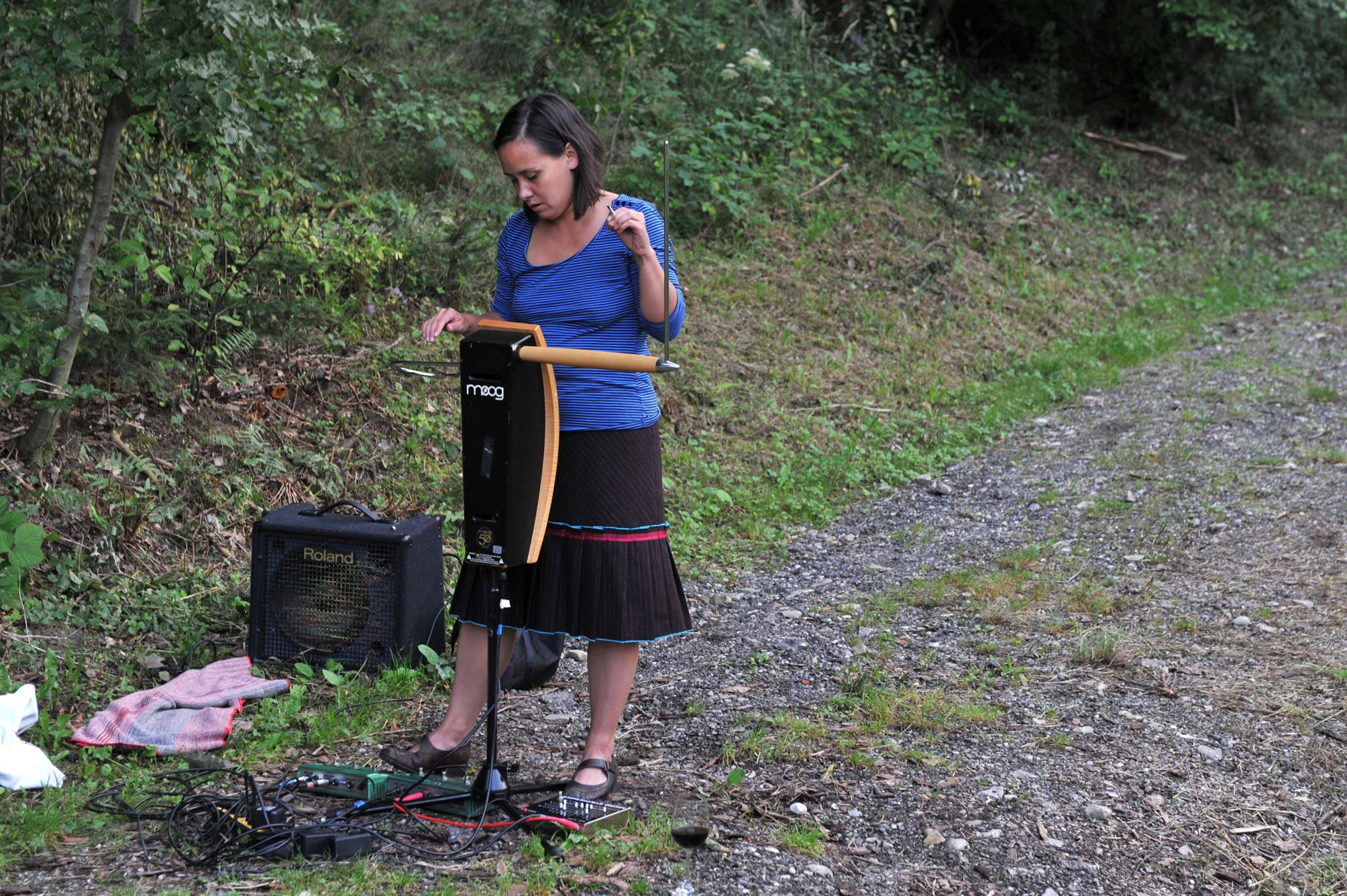
The musician Pamelia Kurstin uses her unusual instrument to produce soundscapes reminiscent of minimal music, but that also call to mind a language in their uniqueness where each word stands for itself. She plays the theremin without any physical contact, solely with interference in radio waves. It is an instrument that not only requires great musical skills but also the ability to improvise completely. One hand alters the pitch, the other the volume. The artist must rely entirely on her ear. Tones can be held for any length of time while remaining alterable at any time.
In her solo concerts the musician generates polyphonic, and with the use of live loops often orchestral-sounding, compositions that she improvises over the top of. She builds-up her pieces slowly, steadily increasing in intensity as intricate tone complexes. For A Solo Performance at the opening of the exhibition, Kurstin positioned her instrument in the middle of a forest path, the Dichterweg (poet's path), behind the Auden House, where she produced fragile, magical sonic structures that appeared to negate spatial boundaries.
Pamelia Kurstin is one of the most noted thereminists in the world. She has worked with many of the great names in experimental music and jazz, like John Zorn, Brad Meldau and Ravi Coltrane, as well as with David Byrne, Yoko Ono and also Otto Lechner, or toured with the jazz-punk rock band Barbez. In addition, Kurstin plays the accompaniment to silent films and works in collaboration with visual artists. Her solo CD Thinking Out Loud is on John Zorn's legendary Tzadik label dedicated to avant-garde and experimental music.
(Cornelia Offergeld)
Images (29)
